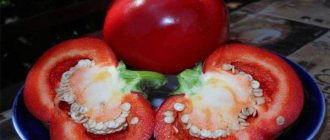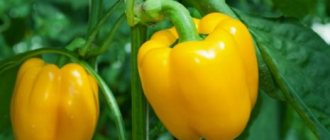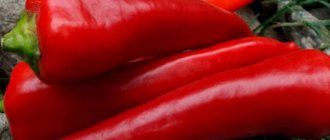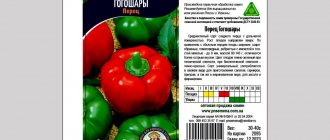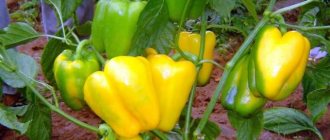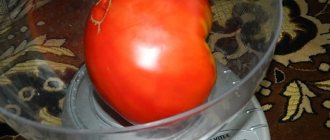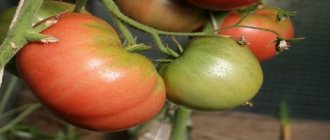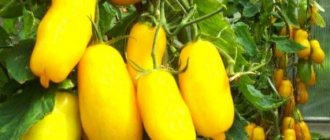Vegetable growing » Pepper
0
1191
Article rating
Kira Stoletova
Among the huge variety of vegetables, the Goliath pepper variety is in great demand in the market. It has earned recognition due to its ease of care and high yield.
Characteristics of the Goliath pepper variety
Description of the plant
Goliath is a mid-season hybrid variety. The plant is powerful and compact. The ripening period ranges from 70 to 75 days from the moment of planting the seedlings. Thanks to the strong leaf apparatus, the plant is protected from sunlight, which can burn it.
The bush has well-developed roots, which are located close to the soil surface. For this reason, care must be taken when loosening to avoid damaging the root system.
Dark green leaves grow on the bush. The formation of the ovary occurs after seven to nine leaves, and subsequent ones - every two to three nodes.
Transplanting seedlings
Sweet and tasty peppers in fertilized soil
Sweet peppers of the Khalif variety grow well in light, loose, well-fertilized soil. In the fall, organic and potassium-phosphorus fertilizers are first applied to it. In spring, it is advisable to enrich the soil with ammonium nitrate (30-40 g per 1 m2).
5-7 days before transplanting seedlings, it is recommended to disinfect the soil using a solution of copper sulfate (1 tablespoon per 10 liters of water).
Seedlings are transplanted into open ground when the soil has warmed up well and the risk of night cold snaps is minimal (late spring-early summer). For greenhouse cultivation, peppers can be planted in early April.
Planting scheme for young peppers Khalif f1: 3-4 bushes are placed per 1 m². It is necessary to place the seedling in the hole at the same depth at which it grew in the nursery, without exposing the root system and without hiding the root collar in the soil. Immediately after transplanting, it is advisable to water and attach the crop to a support installed nearby.
It is advisable to plant this vegetable after legumes, early cabbage, herbs or onions.
Proper care of peppers will give you the opportunity to get the maximum yield of quality vegetables. This ensures that the crop will have good immunity and be less susceptible to diseases and pest attacks typical of these vegetables.
Watering
Watering is carried out in the morning or evening with warm rain or settled water. It is advisable to alternate it with loosening and weeding. This will retain moisture in the soil for a longer time, and air access to the rhizome will improve. Some vegetable growers mulch the soil with straw.
Feeding
Peppers require constant care
It is recommended to fertilize pepper at least 3-4 times during the season. Systematic monitoring of the condition of plants will allow you to quickly determine what substance the soil lacks.
In the phase of appearance of 1-2 true leaves, the first feeding is carried out using the following solution: 2-3 g of superphosphate, 0.5 g of nitrate, 1-2 g of potassium are added to 1 liter of water. After 2 weeks, fertilizing is repeated, increasing the amount of mineral fertilizers up to 2 times.
Popular among gardeners are feeding peppers with nettle infusion and a solution of chicken manure (1:10). It is advisable to alternate them with mineral supplements (1 tablespoon of nitrophoska per 10 liters of water).
It is necessary to regularly apply potassium-phosphorus fertilizers to the soil, which affect the number of ovaries on the crop and the quality of vegetables.
Pruning and shaping the bush
The Khalif pepper bush is described as compact, but this does not relieve the gardener from the need for regular pinching (pruning) of the crop. Its essence is to remove side shoots, which accelerate their growth in wet weather. It is undesirable to carry out pinching in the heat: the presence of additional foliage on the bush protects the soil from rapid evaporation of moisture.
The lowest, longest shoots should be pruned; you should try to achieve maximum illumination of the bush with sunlight. It is also worth removing unnecessary branches of the culture. Stepping is carried out once every 7-10 days, more often if necessary.
The Khalif variety requires the formation of a bush and its subsequent tying. When the crop reaches a height of 20-25 cm, the top, which is located on the main stem, is removed. Of the remaining strong shoots, it is recommended to leave no more than 3-4 stepsons.
To speed up the ripening of vegetables, gardeners advise once again additionally removing the top of the bush plant after half the fruiting period.
Description of the harvest
The seed from which Goliath peppers are grown is quite expensive. However, the cost pays off well, since as a result, vegetable growers harvest much more than from simple popular varieties. On average, up to 12 peppers can be removed from each bush.
Gardeners who grew this vegetable crop on their plots describe the resulting harvest as follows:
- The fruits have a cone shape, reach 6 centimeters in diameter and 14 centimeters in length.
- The weight of each pepper is 130-160 grams.
- The wall thickness is average - 7-8 millimeters, thanks to which vegetables can be stored frozen for quite a long time. In addition, the thickness of the walls allows fruits to be transported over long distances, without losing their marketable characteristics. The shelf life in nets is 14-21 days.
- At the stage of technical maturity, peppers are colored green. Having reached a state of biological ripeness, they acquire a bright red color with a whitish waxy coating.
- The plant bears fruit for a long time and consistently. When the fruits are picked before biological ripeness, they gradually turn red until the New Year holidays.
Pepper Goliath: photos, reviews
Among the huge variety of vegetables, the Goliath pepper variety is in great demand in the market. It has earned recognition due to its ease of care and high yield.
Characteristics of the Goliath pepper variety
Characteristics of the Goliath variety
The Goliath pepper variety belongs to the first generation hybrids. It is resistant to many diseases and produces good yields even with minimal care. Collecting seeds from its fruits for further planting is impractical: they do not retain the varietal characteristics of their parents.
Pepper Goliath F1 is unpretentious to climatic conditions and is suitable for growing in open ground. This hybrid excludes the use of greenhouses and indoor growing facilities.
Description of the bush
The mid-early hybrid has a strong compact bush with a ripening period of 70-75 days from the day of planting. Protection from the scorching summer rays is provided by a powerful leaf apparatus.
The plant has a developed root system. The rhizome is close to the surface of the soil, so you need to loosen it very carefully so as not to damage it.
The leaves are dark green, with a smooth, waxy surface. The ovary begins to form after 7-9 true leaves, and after that every 2-3 nodes.
Description of the fruit
Seeds of this variety have a high cost. As a result, gardeners and farmers get much more fruit than the usual known varieties. The average yield from 1 bush, tested by manufacturers, is 11-12 fruits.
Main characteristics of Goliath sweet pepper:
- The fruits are homogeneous, have a conical shape and a size of 6 × 14 cm. The average weight of the fruit is 130-160 g, they have a small seed chamber, which is important during processing. Some fruits reach a length of 20 cm.
- The wall thickness of the fruit is moderately thick - 7-8 mm. This gives the product an additional advantage: the thick walls of the vegetable make the product juicier and tastier, as well as the possibility of being frozen for a fairly long time.
- Thanks to the thick wall, the fruits are well transported over long distances and retain their presentation for a long time. Products can be stored for 2-3 weeks in a net or in boxes without losing their presentation, shape or quality characteristics.
- When technically ripe, the fruits are green in color. With the onset of biological, it changes to deep red with a whitish waxy coating.
- The fruiting period is stable and long. If the fruits are cut before biological ripening begins, they gradually turn red until the new year.
Planting and caring for the Goliath variety
Plants need to be fertilized
All planting material undergoes preliminary disinfection, so there is no need to additionally prepare the seeds before sowing. Young seedlings need timely watering and feeding.
After transplanting the seedlings to a permanent place, it is necessary to shade the beds for several days. Otherwise, young seedlings may get leaf burns. Before planting, remove all inflorescences and small ovaries. This will help the plants maintain strength and better take root in their new location.
The land for planting is prepared in advance. In the fall, some phosphorus and potassium fertilizers are required, and in the spring, nitrogen fertilizers are required. The remaining parts are applied after planting the seedlings in the fruit formation phase and during the period of mass fruiting. Mulching the soil with black film accelerates the ripening of fruits.
Pests and diseases of the Goliath variety
In comparison with varietal plants, which are often unable to cope with diseases, the price of these seeds corresponds to the investment in fertilizers and plant protection products.
At the same time, the selection seeds are reliably protected from the tobacco mosaic virus, bacterial spot and cancer, Alternaria blight, late blight, gray rot and blackleg, which have become widespread in recent years.
For additional protection from pests, basil is planted between rows. The subshrub is a friend of the nightshade crop and releases substances that stimulate growth.
The greatest danger to pepper bushes is slugs. In cloudy and rainy weather, they love to feast on the fruits of the crop. To combat slugs, leaves and stems are dusted with wood ash.
SIBERIAN PEPPERS ARE GIANTS! GOLIATH VARIETY. Review by Olga Chernova. BEST PRODUCTIVE VARIETIES OF SWEET PEPPER 2017 (08/19/2017) Yield garden and vegetable garden - PEPPER seed review ➤Choosing Pepper seeds careChoosing a hybrid (variety) of sweet pepper
Conclusion
The Goliath pepper hybrid is excellent for growing in open ground. It is resistant to most diseases and pests.
Pepper is suitable for growing on an industrial scale due to its high yield. It also easily tolerates transportation without losing its presentation.
Source: https://FermoVed.ru/perets/goliaf.html
Sweet pepper Siberian bonus “Siberian Garden”
Rare color, enviable size!
Large-fruited, beautiful and productive variety of Siberian selection with fruits of rare orange color. The plant is up to 80 cm high, with a closed bush shape that hides a large number of set fruits, which in technical ripeness match the color of the dark green foliage.
When ripe, orange-orange fruits wonderfully transform the plant, illuminating the dense greenery with bright sunlight. The bush produces up to 15 qualitatively standard large cubic fruits weighing up to 300 grams, with a pericarp wall thickness of up to 10 mm.
The thick-walled fruits, which do not contain the bitter substance capsaicin, have a pronounced peppery aroma, sweet taste and delicate texture, and are able to ripen well without losing their elasticity.
The variety is recommended for cultivation in greenhouses and open ground. Suitable for fresh consumption and all types of processing.
Productivity up to 3 kg per plant. To increase productivity, it is recommended to follow the regime of mineral nutrition and watering, and promptly collect fruits that have reached technical maturity.
Sowing of seedlings is carried out 60-70 days before planting the plants in a permanent place. The optimal constant temperature for seed germination is 26-28°C. When planting in the ground for 1 sq. m place 5-7 plants. The variety responds well to watering and fertilizing with complex mineral fertilizers.
To speed up the process of seed germination, improve plant health, and improve fruit set, it is recommended to use specially developed plant growth and development stimulants.
We are glad to welcome you to our online seed store!
We, just like you, love to grow beautiful flowers and delight our loved ones with the harvest. SemenaLuxe is an independent store. We offer products only from trusted suppliers. We thank our long-term partners: “Gavrish9raquo;”, “Russian Garden”, “Agrico”, “Biotechnika”, “Siberian Garden”, “Aelita”, “Prestige”, “Fasco”, “August”, “Green Pharmacy”.
When ordering seeds from us, you can be sure:
• we do not replace the seeds you have chosen with similar ones;
• we make every effort to ensure that you receive your order as quickly as possible;
We look forward to long-term cooperation and strong friendship with you.
Have a rich harvest!
The most popular and best varieties of sweet peppers for Siberia
The use of pepper is not limited to just one culinary area. It is actively used in medicine: traditional and folk. The product is rich in nutrients. Every gardener knows that such a vegetable is a light- and heat-loving crop.
But this does not prevent it from being grown in Siberia. After all, there are many varieties. For growing in cold climate regions, the main thing is to choose a suitable, hardy variety. The best varieties of sweet pepper for Siberia will be described in the article.
How to choose a variety?
The peculiarity of pepper is that it is highly resistant to various diseases. It can be grown in any type of soil. Previously, such a heat-loving plant was usually found only in gardens located in the southern regions. Today, various types of covering agents have appeared. It has become possible to cultivate bell peppers in the Siberian region.
When choosing seeds for planting, you need to pay attention to the following points:
- The packaging must indicate that the variety is for Siberia.
- Shelf life of seeds.
- Packing date. It is advisable that it is not two years old.
How to plant and care for peppers in Siberia?
In the Siberian Territory, the process of sowing pepper seeds is usually done in March.
It is important that the ground temperature does not fall below +25 degrees. Since seedlings do not tolerate transplantation well, use cups in which 2 seeds are planted.
To plant seedlings, it is better to choose a place at a height that is well lit. A distance of 85 centimeters is maintained between rows. Irrigation is done after the plant has taken root. The soil should be loosened carefully.
Otherwise, there is a risk of damaging the root system. There is no need to fertilize with manure. It is better to add minerals in small doses. Ripe fruits must be removed on time.
Otherwise, this will become an obstacle to the growth of new and maturation of immature specimens.
Thus, although pepper is a heat-loving plant, it is also actively grown in Siberia.
And all thanks to the fact that breeders have developed early-ripening, best varieties that are resistant to low temperatures. There are quite a lot of varieties today. Therefore, summer residents do not have problems with the choice.
The main thing is that the seeds are of high quality. Otherwise, everything depends on the gardener, compliance with agricultural technology and care.
Source: https://selok.info/ovoshhevodstvo/perets/perets-goliath-foto-otzyvy/
How to plant and care for the variety
Before going on sale, all seeds of this hybrid variety are pre-disinfected. For this reason, there is no need to carry out additional treatment before sowing. Young shoots must be watered and fed in a timely manner.
After the seedlings are planted in open ground, the beds need to be shaded for several days. If this is not done, the sun's rays can burn the leaves of young seedlings. Before planting seedlings in a permanent place, you need to cut off all the inflorescences and small ovaries. Thanks to this, the plant’s adaptation to the new site will be faster and better.
The soil for planting seedlings is prepared in advance. In the fall, it needs to be fertilized with fertilizers containing phosphorus and potassium, and in the spring with those that contain nitrogen. You also need to apply fertilizer after planting seedlings at the stage of fruit formation and during active fruiting. In order for the peppers to ripen more quickly, it is necessary to mulch the soil with a dark film.
Tall
This group includes vegetable crops that have a tall bush. In this case, care should involve not only irrigation, loosening, but also tying up the crop.
Arrogant
The bush height of this plant reaches 1 m. At the ripe stage they have a bright red color. The shape of the product is heart-shaped and prism-shaped. It can weigh 160-250 g.
In one season you can collect 15 pieces from one bush. Zaznaika is a vegetable crop that is characterized by juiciness and meatiness. The growing process takes place in open areas.
Zorka
A tall plant that ripens early. Large, and their color is scarlet. The pulp is characterized by sweetness and juiciness.
Atlantic F1
An early-ripening hybrid with elongated, fleshy legs. Their sizes are quite large, the weight of one pepper can reach 300-500 g. The color of the product is dark red.
Cardinal F1
The hybrid is also included in the tall group. Characterized by their high meatiness. The weight of one pepper reaches 250 g. The color is purple.
Red elephant
An early ripening tall crop with an elongated conical shape. The size of the vegetable is average, the weight of one will be 130-210 g. It has a dark red color scheme.
Orange miracle F1
A high-yielding early-ripening variety, the height of which is 110 cm. They are characterized by their fleshiness and bright orange color. The weight of one pepper reaches 250 g.
Triton
This crop is characterized by a very early maturity. The shape is cone-shaped, the dimensions are medium. The weight of one pepper reaches 150 g. The color of the vegetable is red.
The variety has early ripening. Depending on the degree of ripening, it changes color from yellow to orange.
ox ear
The crop is mid-season, the shape is presented in the form of an elongated cone. The weight of one pepper reaches 115-140 g. A mature specimen has a dark red color.
Barguzin
The bush is large. Ripe species are yellow or light orange in color. The shape of the pepper is presented in the form of a narrow, elongated cone. The weight of the ripe product reaches 150 g.
If favorable growing conditions have been created, then in one season it is possible to collect 15-18 juicy pieces. This type of crop adapts perfectly to different growing conditions.
Cornet
The bush height of this plant reaches more than 1 m. A ripe specimen has a dark brown color. The shape of the fruit is presented in the form of a cone. The mass of one is 200-250 g.
The quality of fruiting depends on the conditions in which the crop was maintained. Continuous fruiting is achieved throughout the entire growing season.
The video shows early varieties of sweet peppers for open ground:
Today there are a large number of different varieties of sweet peppers. Choosing the right one is very easy if you know the characteristics of each in advance. If you still cannot decide on the appropriate variety, then you should get advice from a specialist.
Diseases and pests
The hybrid variety Goliath is highly resistant to many pests and diseases that often affect sweet peppers, including tobacco mosaic virus, late blight, gray rot, bacterial spot and other diseases.
To further protect the plant from harmful insects, it is recommended to plant basil between the rows, which releases elements that stimulate the growth of the nightshade crop.
Slugs are considered the most dangerous pests for this plant. During the rainy and insufficiently sunny season, they like to feast on peppers. To prevent attacks by these harmful insects, you should sprinkle the leaves and stems of bushes with wood ash.
Landing
Plants need to be fertilized
All planting material undergoes preliminary disinfection, so there is no need to additionally prepare the seeds before sowing. Young seedlings need timely watering and feeding.
The land for planting is prepared in advance. In the fall, some phosphorus and potassium fertilizers are required, and in the spring, nitrogen fertilizers are required. The remaining parts are applied after planting the seedlings in the fruit formation phase and during the period of mass fruiting. Mulching the soil with black film accelerates the ripening of fruits.
Sowing work begins in mid-February. Before planting, seeds are soaked and then disinfected in potassium permanganate, peroxide or Fitosporin.
When the seedlings appear, the seedlings are exposed to light and phytolamps are connected. At the age of 60-65 days, the seedlings are transplanted into beds. The layout is 40 by 60 cm.
We suggest you familiarize yourself with Canning Red Hot Pepper
Peppers need watering up to 2-3 times a week in dry summers; during the rainy season, make sure the beds dry out. The next day after moistening, loosening is carried out. The hilling procedure gives a good effect.
The feeding scheme looks like this:
- 12-14 days after transplantation, nitrogen compounds (urea, Azotovit), complex preparations are added;
- in case of mass flowering, superphosphate and complexes (Agricola, Clean Sheet, Fertika) are used;
- When ripe, fertilize 2-3 times with an interval of 2 weeks; phosphorus and potassium salts are used in equal proportions.
Landing
The sowing period takes place during February - March. During this time, you need to have time to prepare and sow the seeds in nutritious soil. Seed material is soaked for disinfection in potassium permanganate and biological preparations. To germinate for a couple of days, the grains are laid out on moistened, breathable material, wrapped and covered with film.
The moisture content of the fabric is checked regularly and, if necessary, it is moistened with warm water.
From the 3rd day, the polyethylene is removed so that the seeds do not rot. The temperature is maintained at 26-28 degrees. The boxes are filled with loose fertilized substrate, which is made up of turf, compost, and vermicompost. For 10 kg of mixture, 30 g of phosphorus-potassium additive is required. The earth is also disinfected by freezing or calcination. You can use Bordeaux mixture, Fitosporin, potassium permanganate.
The seeds are laid out in grooves in increments of 4 cm, the depth of which is up to 1 cm. Before germination, microgreenhouse conditions are created, for this purpose the temperature is maintained at 20-25 degrees and the humidity is 60-70%.
When the seedlings grow 2 leaves, pick them into separate cups. Be sure to monitor watering and use water at room temperature.
Before planting in permanent areas, the bushes are hardened off. To do this, the seedlings are placed on the balcony from 15-20 minutes to 5-6 hours (after 7-10 days).
60-70 day old plants are moved to the beds. Up to 3-4 bushes are planted per 1 m2, taking into account their further powerful growth. The predecessors for pepper will be:
- pumpkin and zucchini;
- cucumbers and melons;
- onion and garlic;
- greens and celery;
- legumes;
- onions and beets.
